Earthquake Risk Management Plan: Gujarat, India - Analysis
VerifiedAdded on 2023/06/07
|10
|1968
|179
Report
AI Summary
This report outlines a comprehensive earthquake risk management plan specifically designed for Gujarat, India. It begins by establishing the project's aim, objectives, and research questions, followed by a detailed methodology. The report emphasizes the need for a robust risk and disaster management plan, analyzing earthquake vulnerability across physical, structural, and social dimensions. It then proposes various preparedness measures, highlighting the roles and responsibilities of different state government departments, including Agriculture & Cooperation, Animal Husbandry, Civil Aviation, and Education. The report further addresses the importance of capacity building, material preparedness, and the coordination of disaster response efforts. The analysis draws from the 2001 Kutch Earthquake experience, emphasizing a multi-agency, multi-department, and multi-level approach to disaster management. Finally, the report references key literature and policies to support its findings and recommendations, aiming to enhance the state's resilience to future earthquake events.
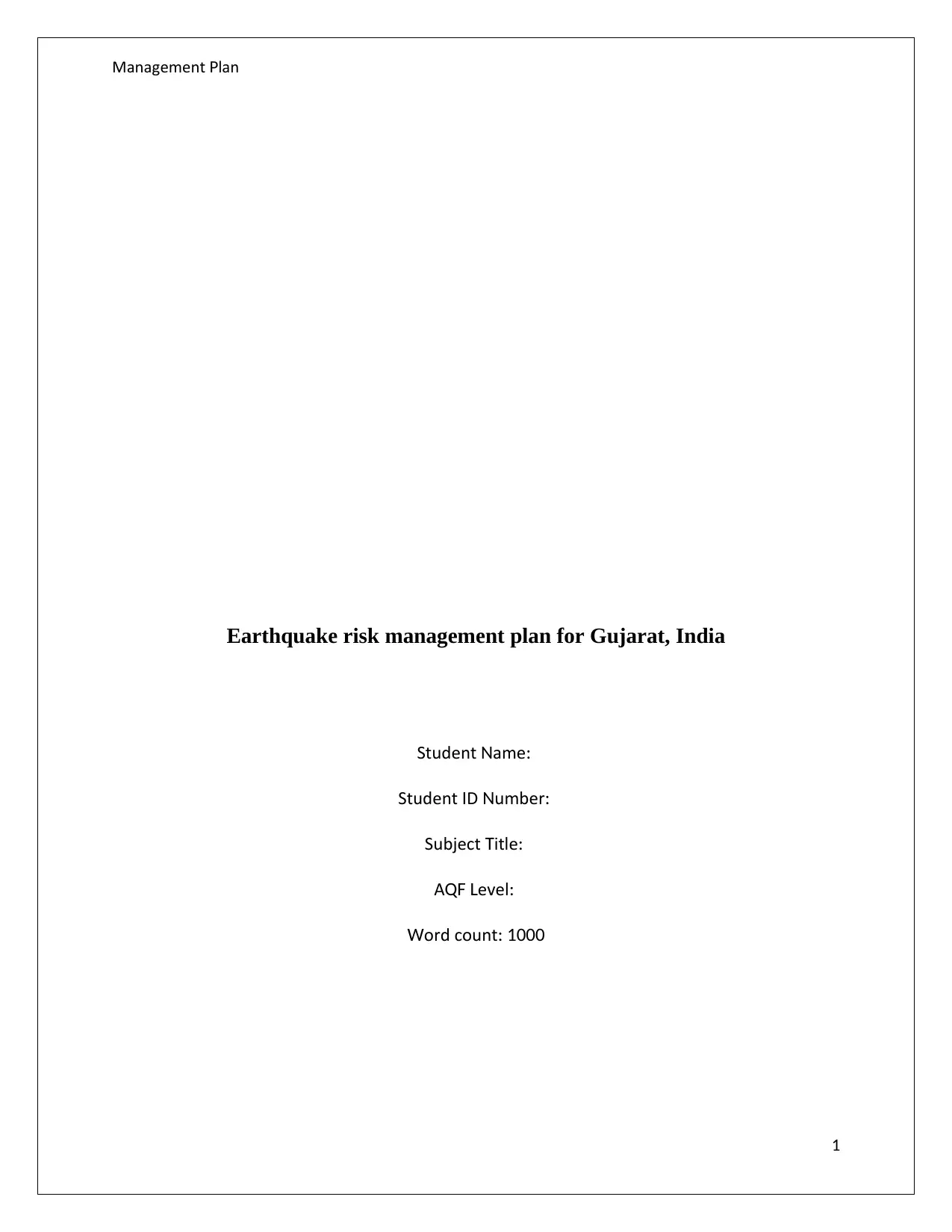
Management lanP
Earthquake risk management plan for Gujarat, India
Student ameN :
Student D umberI N :
Subject itleT :
A evelQF L :
ord countW : 1000
1
Earthquake risk management plan for Gujarat, India
Student ameN :
Student D umberI N :
Subject itleT :
A evelQF L :
ord countW : 1000
1
Paraphrase This Document
Need a fresh take? Get an instant paraphrase of this document with our AI Paraphraser
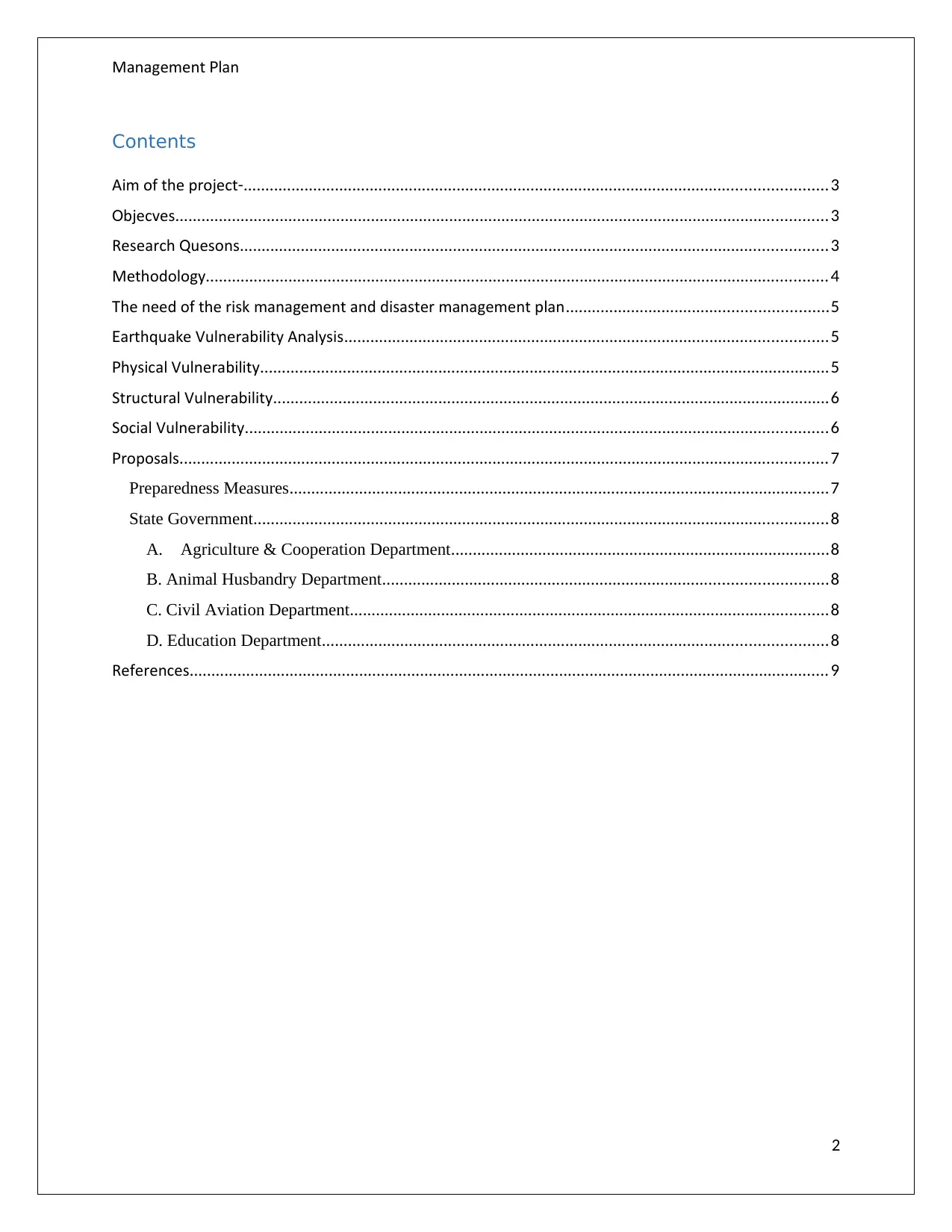
Management lanP
Contents
Aim of the project-......................................................................................................................................3
bjectivesO ......................................................................................................................................................3
Research uestionsQ .......................................................................................................................................3
Methodology...............................................................................................................................................4
he need of the risk management and disaster management planT ............................................................5
arthquake Vulnerability AnalysisE ...............................................................................................................5
hysical VulnerabilityP ...................................................................................................................................5
Structural Vulnerability................................................................................................................................6
Social Vulnerability......................................................................................................................................6
roposalsP ..................................................................................................................................................... 7
Preparedness Measures............................................................................................................................7
State Government....................................................................................................................................8
A. Agriculture & Cooperation Department.......................................................................................8
B. Animal Husbandry Department......................................................................................................8
C. Civil Aviation Department..............................................................................................................8
D. Education Department....................................................................................................................8
References...................................................................................................................................................9
2
Contents
Aim of the project-......................................................................................................................................3
bjectivesO ......................................................................................................................................................3
Research uestionsQ .......................................................................................................................................3
Methodology...............................................................................................................................................4
he need of the risk management and disaster management planT ............................................................5
arthquake Vulnerability AnalysisE ...............................................................................................................5
hysical VulnerabilityP ...................................................................................................................................5
Structural Vulnerability................................................................................................................................6
Social Vulnerability......................................................................................................................................6
roposalsP ..................................................................................................................................................... 7
Preparedness Measures............................................................................................................................7
State Government....................................................................................................................................8
A. Agriculture & Cooperation Department.......................................................................................8
B. Animal Husbandry Department......................................................................................................8
C. Civil Aviation Department..............................................................................................................8
D. Education Department....................................................................................................................8
References...................................................................................................................................................9
2
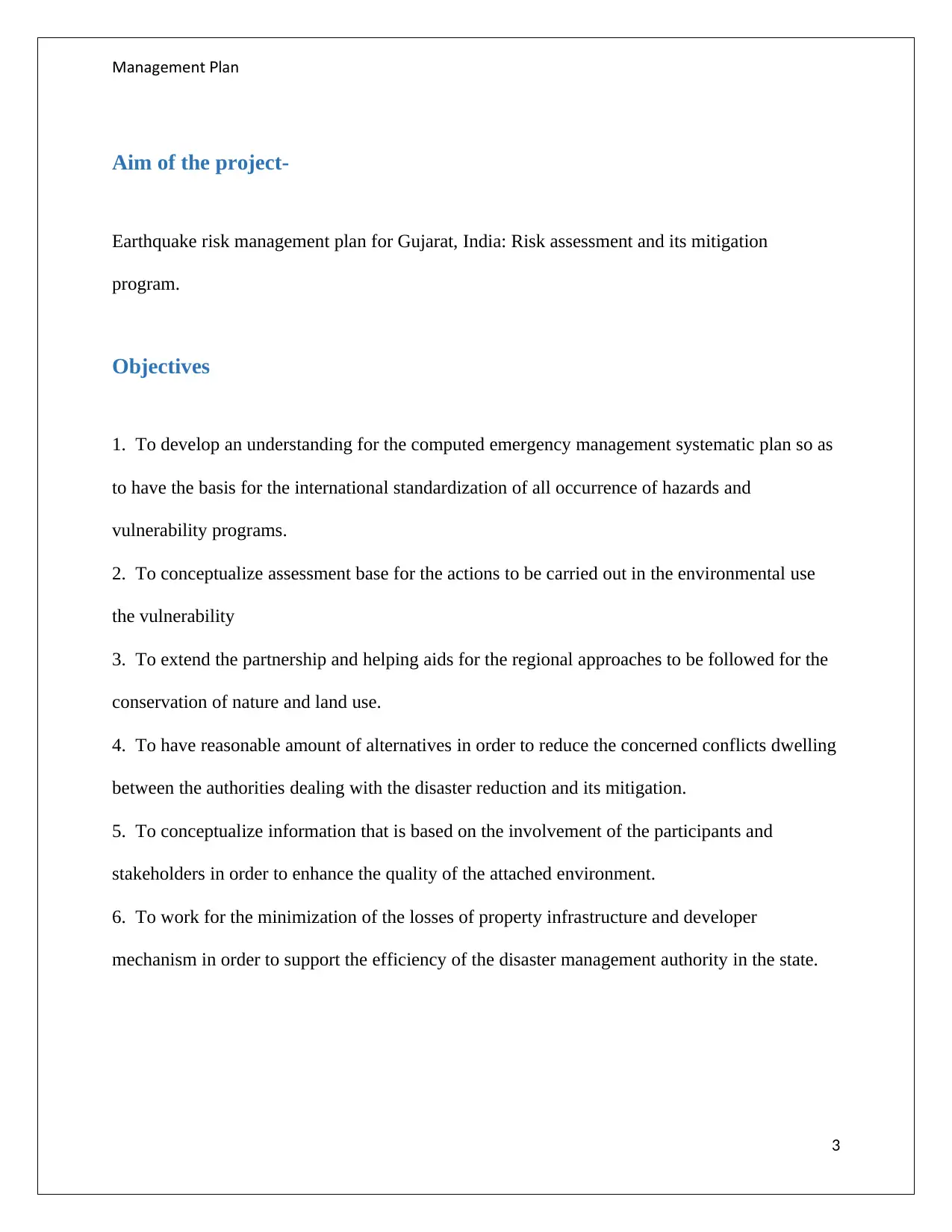
Management lanP
Aim of the project-
Earthquake risk management plan for Gujarat, India: Risk assessment and its mitigation
program.
Objectives
1. To develop an understanding for the computed emergency management systematic plan so as
to have the basis for the international standardization of all occurrence of hazards and
vulnerability programs.
2. To conceptualize assessment base for the actions to be carried out in the environmental use
the vulnerability
3. To extend the partnership and helping aids for the regional approaches to be followed for the
conservation of nature and land use.
4. To have reasonable amount of alternatives in order to reduce the concerned conflicts dwelling
between the authorities dealing with the disaster reduction and its mitigation.
5. To conceptualize information that is based on the involvement of the participants and
stakeholders in order to enhance the quality of the attached environment.
6. To work for the minimization of the losses of property infrastructure and developer
mechanism in order to support the efficiency of the disaster management authority in the state.
3
Aim of the project-
Earthquake risk management plan for Gujarat, India: Risk assessment and its mitigation
program.
Objectives
1. To develop an understanding for the computed emergency management systematic plan so as
to have the basis for the international standardization of all occurrence of hazards and
vulnerability programs.
2. To conceptualize assessment base for the actions to be carried out in the environmental use
the vulnerability
3. To extend the partnership and helping aids for the regional approaches to be followed for the
conservation of nature and land use.
4. To have reasonable amount of alternatives in order to reduce the concerned conflicts dwelling
between the authorities dealing with the disaster reduction and its mitigation.
5. To conceptualize information that is based on the involvement of the participants and
stakeholders in order to enhance the quality of the attached environment.
6. To work for the minimization of the losses of property infrastructure and developer
mechanism in order to support the efficiency of the disaster management authority in the state.
3
⊘ This is a preview!⊘
Do you want full access?
Subscribe today to unlock all pages.

Trusted by 1+ million students worldwide
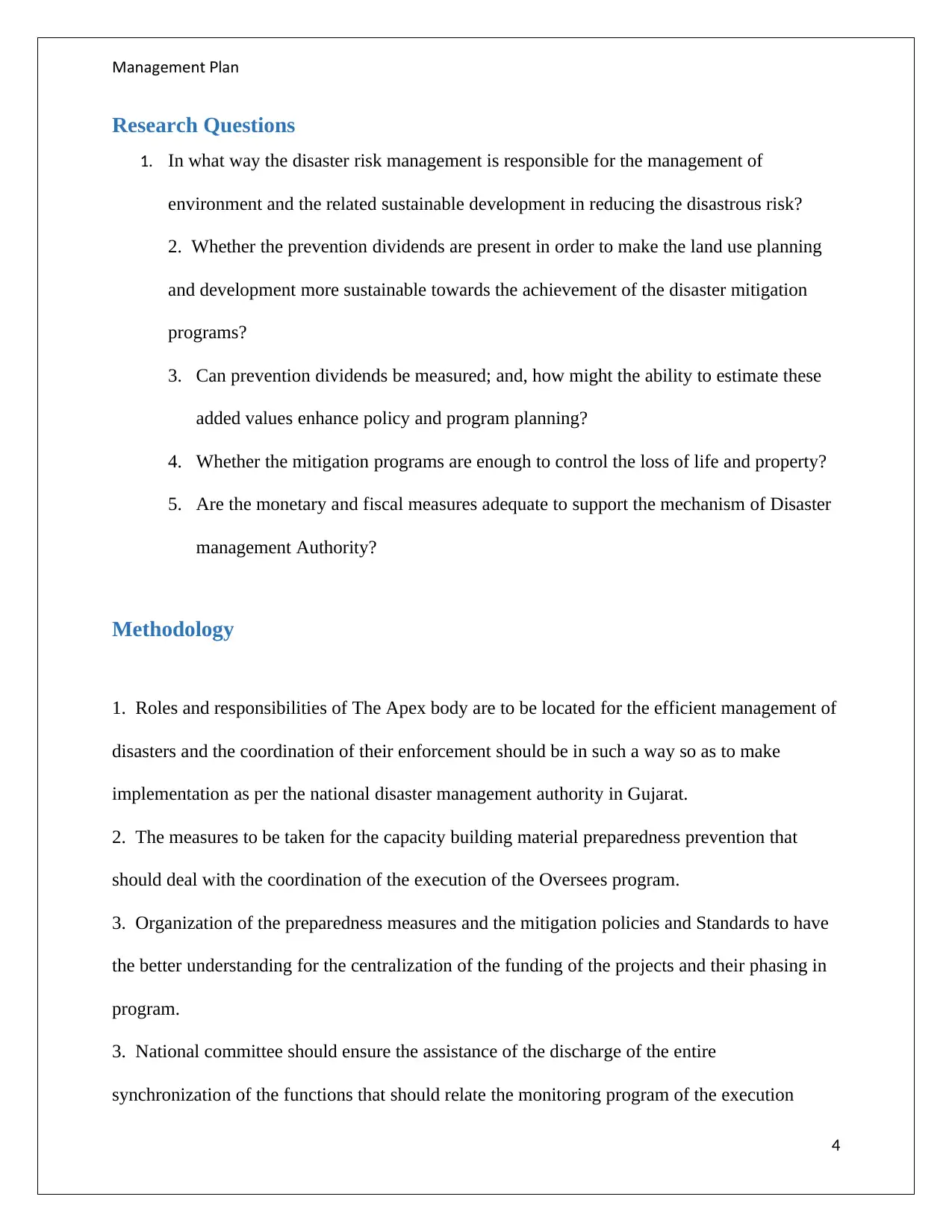
Management lanP
Research Questions
1. In what way the disaster risk management is responsible for the management of
environment and the related sustainable development in reducing the disastrous risk?
2. Whether the prevention dividends are present in order to make the land use planning
and development more sustainable towards the achievement of the disaster mitigation
programs?
3. Can prevention dividends be measured; and, how might the ability to estimate these
added values enhance policy and program planning?
4. Whether the mitigation programs are enough to control the loss of life and property?
5. Are the monetary and fiscal measures adequate to support the mechanism of Disaster
management Authority?
Methodology
1. Roles and responsibilities of The Apex body are to be located for the efficient management of
disasters and the coordination of their enforcement should be in such a way so as to make
implementation as per the national disaster management authority in Gujarat.
2. The measures to be taken for the capacity building material preparedness prevention that
should deal with the coordination of the execution of the Oversees program.
3. Organization of the preparedness measures and the mitigation policies and Standards to have
the better understanding for the centralization of the funding of the projects and their phasing in
program.
3. National committee should ensure the assistance of the discharge of the entire
synchronization of the functions that should relate the monitoring program of the execution
4
Research Questions
1. In what way the disaster risk management is responsible for the management of
environment and the related sustainable development in reducing the disastrous risk?
2. Whether the prevention dividends are present in order to make the land use planning
and development more sustainable towards the achievement of the disaster mitigation
programs?
3. Can prevention dividends be measured; and, how might the ability to estimate these
added values enhance policy and program planning?
4. Whether the mitigation programs are enough to control the loss of life and property?
5. Are the monetary and fiscal measures adequate to support the mechanism of Disaster
management Authority?
Methodology
1. Roles and responsibilities of The Apex body are to be located for the efficient management of
disasters and the coordination of their enforcement should be in such a way so as to make
implementation as per the national disaster management authority in Gujarat.
2. The measures to be taken for the capacity building material preparedness prevention that
should deal with the coordination of the execution of the Oversees program.
3. Organization of the preparedness measures and the mitigation policies and Standards to have
the better understanding for the centralization of the funding of the projects and their phasing in
program.
3. National committee should ensure the assistance of the discharge of the entire
synchronization of the functions that should relate the monitoring program of the execution
4
Paraphrase This Document
Need a fresh take? Get an instant paraphrase of this document with our AI Paraphraser
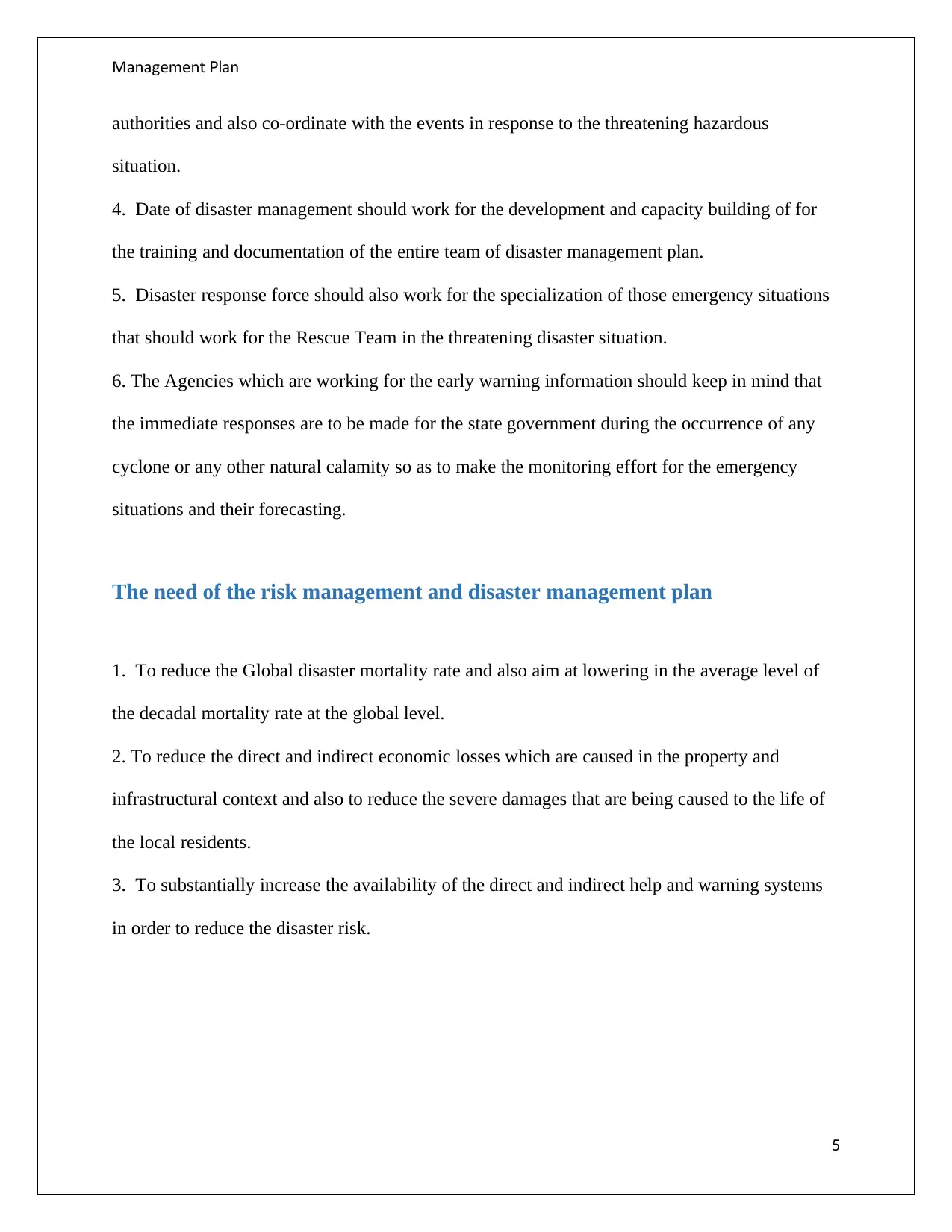
Management lanP
authorities and also co-ordinate with the events in response to the threatening hazardous
situation.
4. Date of disaster management should work for the development and capacity building of for
the training and documentation of the entire team of disaster management plan.
5. Disaster response force should also work for the specialization of those emergency situations
that should work for the Rescue Team in the threatening disaster situation.
6. The Agencies which are working for the early warning information should keep in mind that
the immediate responses are to be made for the state government during the occurrence of any
cyclone or any other natural calamity so as to make the monitoring effort for the emergency
situations and their forecasting.
The need of the risk management and disaster management plan
1. To reduce the Global disaster mortality rate and also aim at lowering in the average level of
the decadal mortality rate at the global level.
2. To reduce the direct and indirect economic losses which are caused in the property and
infrastructural context and also to reduce the severe damages that are being caused to the life of
the local residents.
3. To substantially increase the availability of the direct and indirect help and warning systems
in order to reduce the disaster risk.
5
authorities and also co-ordinate with the events in response to the threatening hazardous
situation.
4. Date of disaster management should work for the development and capacity building of for
the training and documentation of the entire team of disaster management plan.
5. Disaster response force should also work for the specialization of those emergency situations
that should work for the Rescue Team in the threatening disaster situation.
6. The Agencies which are working for the early warning information should keep in mind that
the immediate responses are to be made for the state government during the occurrence of any
cyclone or any other natural calamity so as to make the monitoring effort for the emergency
situations and their forecasting.
The need of the risk management and disaster management plan
1. To reduce the Global disaster mortality rate and also aim at lowering in the average level of
the decadal mortality rate at the global level.
2. To reduce the direct and indirect economic losses which are caused in the property and
infrastructural context and also to reduce the severe damages that are being caused to the life of
the local residents.
3. To substantially increase the availability of the direct and indirect help and warning systems
in order to reduce the disaster risk.
5
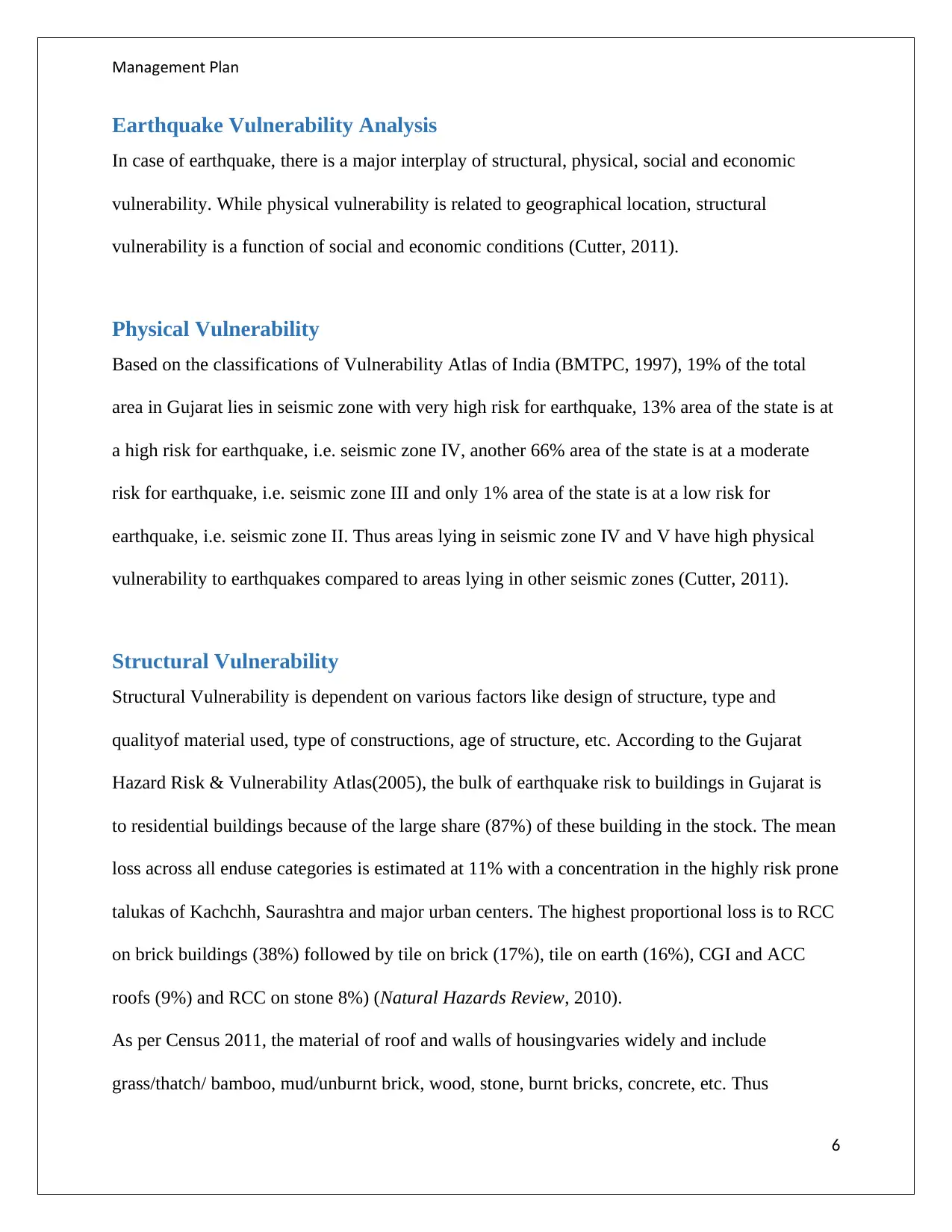
Management lanP
Earthquake Vulnerability Analysis
In case of earthquake, there is a major interplay of structural, physical, social and economic
vulnerability. While physical vulnerability is related to geographical location, structural
vulnerability is a function of social and economic conditions (Cutter, 2011).
Physical Vulnerability
Based on the classifications of Vulnerability Atlas of India (BMTPC, 1997), 19% of the total
area in Gujarat lies in seismic zone with very high risk for earthquake, 13% area of the state is at
a high risk for earthquake, i.e. seismic zone IV, another 66% area of the state is at a moderate
risk for earthquake, i.e. seismic zone III and only 1% area of the state is at a low risk for
earthquake, i.e. seismic zone II. Thus areas lying in seismic zone IV and V have high physical
vulnerability to earthquakes compared to areas lying in other seismic zones (Cutter, 2011).
Structural Vulnerability
Structural Vulnerability is dependent on various factors like design of structure, type and
qualityof material used, type of constructions, age of structure, etc. According to the Gujarat
Hazard Risk & Vulnerability Atlas(2005), the bulk of earthquake risk to buildings in Gujarat is
to residential buildings because of the large share (87%) of these building in the stock. The mean
loss across all enduse categories is estimated at 11% with a concentration in the highly risk prone
talukas of Kachchh, Saurashtra and major urban centers. The highest proportional loss is to RCC
on brick buildings (38%) followed by tile on brick (17%), tile on earth (16%), CGI and ACC
roofs (9%) and RCC on stone 8%) (Natural Hazards Review, 2010).
As per Census 2011, the material of roof and walls of housingvaries widely and include
grass/thatch/ bamboo, mud/unburnt brick, wood, stone, burnt bricks, concrete, etc. Thus
6
Earthquake Vulnerability Analysis
In case of earthquake, there is a major interplay of structural, physical, social and economic
vulnerability. While physical vulnerability is related to geographical location, structural
vulnerability is a function of social and economic conditions (Cutter, 2011).
Physical Vulnerability
Based on the classifications of Vulnerability Atlas of India (BMTPC, 1997), 19% of the total
area in Gujarat lies in seismic zone with very high risk for earthquake, 13% area of the state is at
a high risk for earthquake, i.e. seismic zone IV, another 66% area of the state is at a moderate
risk for earthquake, i.e. seismic zone III and only 1% area of the state is at a low risk for
earthquake, i.e. seismic zone II. Thus areas lying in seismic zone IV and V have high physical
vulnerability to earthquakes compared to areas lying in other seismic zones (Cutter, 2011).
Structural Vulnerability
Structural Vulnerability is dependent on various factors like design of structure, type and
qualityof material used, type of constructions, age of structure, etc. According to the Gujarat
Hazard Risk & Vulnerability Atlas(2005), the bulk of earthquake risk to buildings in Gujarat is
to residential buildings because of the large share (87%) of these building in the stock. The mean
loss across all enduse categories is estimated at 11% with a concentration in the highly risk prone
talukas of Kachchh, Saurashtra and major urban centers. The highest proportional loss is to RCC
on brick buildings (38%) followed by tile on brick (17%), tile on earth (16%), CGI and ACC
roofs (9%) and RCC on stone 8%) (Natural Hazards Review, 2010).
As per Census 2011, the material of roof and walls of housingvaries widely and include
grass/thatch/ bamboo, mud/unburnt brick, wood, stone, burnt bricks, concrete, etc. Thus
6
⊘ This is a preview!⊘
Do you want full access?
Subscribe today to unlock all pages.

Trusted by 1+ million students worldwide
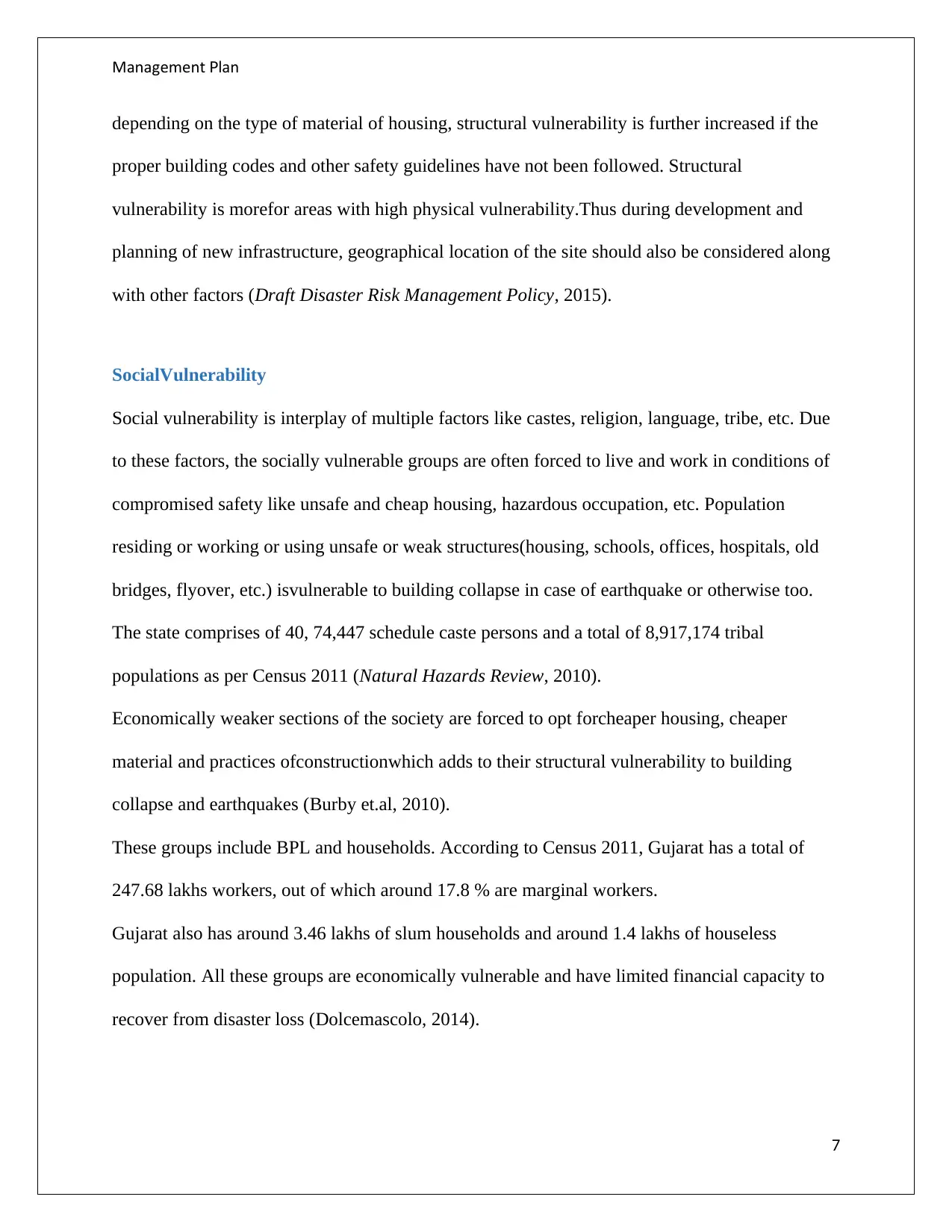
Management lanP
depending on the type of material of housing, structural vulnerability is further increased if the
proper building codes and other safety guidelines have not been followed. Structural
vulnerability is morefor areas with high physical vulnerability.Thus during development and
planning of new infrastructure, geographical location of the site should also be considered along
with other factors (Draft Disaster Risk Management Policy, 2015).
SocialVulnerability
Social vulnerability is interplay of multiple factors like castes, religion, language, tribe, etc. Due
to these factors, the socially vulnerable groups are often forced to live and work in conditions of
compromised safety like unsafe and cheap housing, hazardous occupation, etc. Population
residing or working or using unsafe or weak structures(housing, schools, offices, hospitals, old
bridges, flyover, etc.) isvulnerable to building collapse in case of earthquake or otherwise too.
The state comprises of 40, 74,447 schedule caste persons and a total of 8,917,174 tribal
populations as per Census 2011 (Natural Hazards Review, 2010).
Economically weaker sections of the society are forced to opt forcheaper housing, cheaper
material and practices ofconstructionwhich adds to their structural vulnerability to building
collapse and earthquakes (Burby et.al, 2010).
These groups include BPL and households. According to Census 2011, Gujarat has a total of
247.68 lakhs workers, out of which around 17.8 % are marginal workers.
Gujarat also has around 3.46 lakhs of slum households and around 1.4 lakhs of houseless
population. All these groups are economically vulnerable and have limited financial capacity to
recover from disaster loss (Dolcemascolo, 2014).
7
depending on the type of material of housing, structural vulnerability is further increased if the
proper building codes and other safety guidelines have not been followed. Structural
vulnerability is morefor areas with high physical vulnerability.Thus during development and
planning of new infrastructure, geographical location of the site should also be considered along
with other factors (Draft Disaster Risk Management Policy, 2015).
SocialVulnerability
Social vulnerability is interplay of multiple factors like castes, religion, language, tribe, etc. Due
to these factors, the socially vulnerable groups are often forced to live and work in conditions of
compromised safety like unsafe and cheap housing, hazardous occupation, etc. Population
residing or working or using unsafe or weak structures(housing, schools, offices, hospitals, old
bridges, flyover, etc.) isvulnerable to building collapse in case of earthquake or otherwise too.
The state comprises of 40, 74,447 schedule caste persons and a total of 8,917,174 tribal
populations as per Census 2011 (Natural Hazards Review, 2010).
Economically weaker sections of the society are forced to opt forcheaper housing, cheaper
material and practices ofconstructionwhich adds to their structural vulnerability to building
collapse and earthquakes (Burby et.al, 2010).
These groups include BPL and households. According to Census 2011, Gujarat has a total of
247.68 lakhs workers, out of which around 17.8 % are marginal workers.
Gujarat also has around 3.46 lakhs of slum households and around 1.4 lakhs of houseless
population. All these groups are economically vulnerable and have limited financial capacity to
recover from disaster loss (Dolcemascolo, 2014).
7
Paraphrase This Document
Need a fresh take? Get an instant paraphrase of this document with our AI Paraphraser
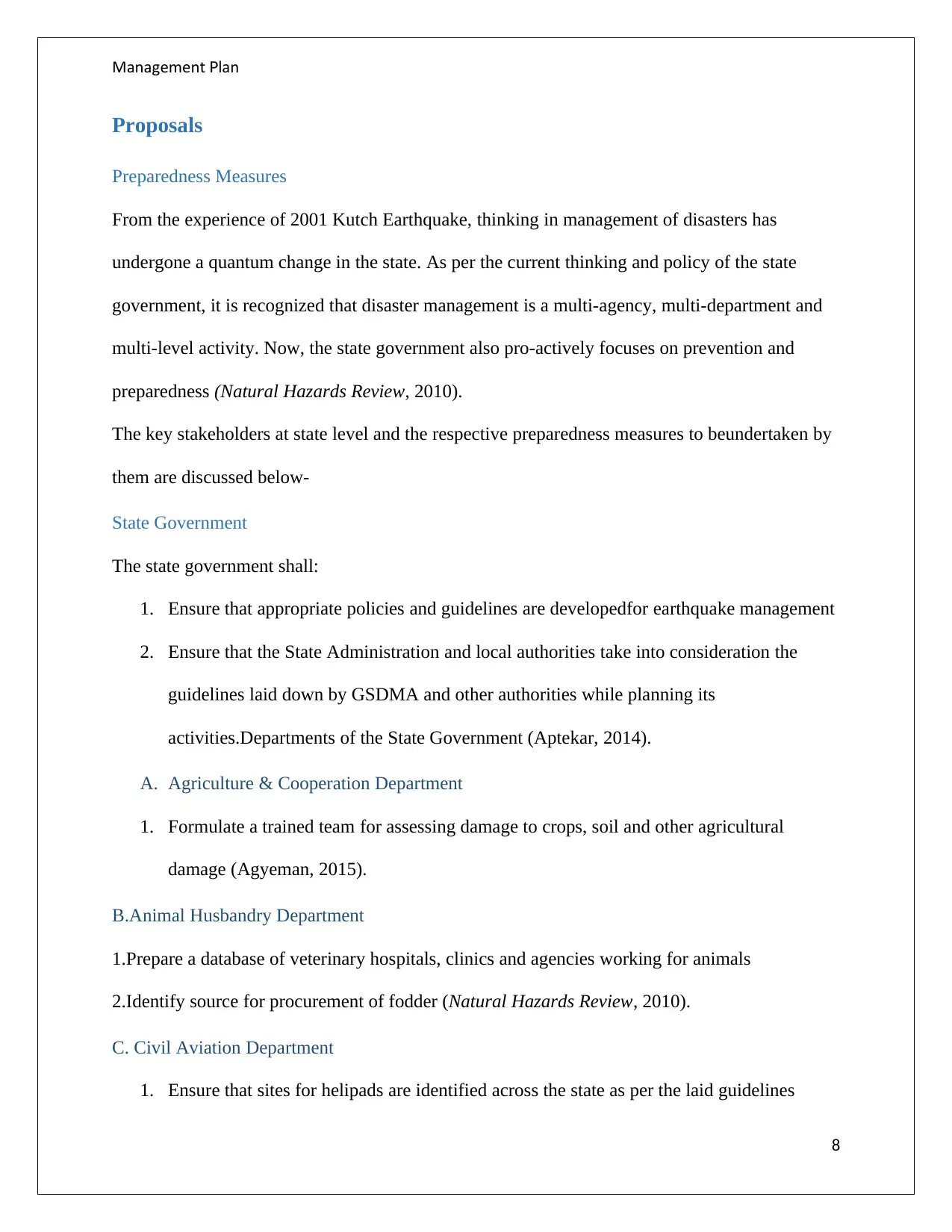
Management lanP
Proposals
Preparedness Measures
From the experience of 2001 Kutch Earthquake, thinking in management of disasters has
undergone a quantum change in the state. As per the current thinking and policy of the state
government, it is recognized that disaster management is a multi-agency, multi-department and
multi-level activity. Now, the state government also pro-actively focuses on prevention and
preparedness (Natural Hazards Review, 2010).
The key stakeholders at state level and the respective preparedness measures to beundertaken by
them are discussed below-
State Government
The state government shall:
1. Ensure that appropriate policies and guidelines are developedfor earthquake management
2. Ensure that the State Administration and local authorities take into consideration the
guidelines laid down by GSDMA and other authorities while planning its
activities.Departments of the State Government (Aptekar, 2014).
A. Agriculture & Cooperation Department
1. Formulate a trained team for assessing damage to crops, soil and other agricultural
damage (Agyeman, 2015).
B.Animal Husbandry Department
1.Prepare a database of veterinary hospitals, clinics and agencies working for animals
2.Identify source for procurement of fodder (Natural Hazards Review, 2010).
C. Civil Aviation Department
1. Ensure that sites for helipads are identified across the state as per the laid guidelines
8
Proposals
Preparedness Measures
From the experience of 2001 Kutch Earthquake, thinking in management of disasters has
undergone a quantum change in the state. As per the current thinking and policy of the state
government, it is recognized that disaster management is a multi-agency, multi-department and
multi-level activity. Now, the state government also pro-actively focuses on prevention and
preparedness (Natural Hazards Review, 2010).
The key stakeholders at state level and the respective preparedness measures to beundertaken by
them are discussed below-
State Government
The state government shall:
1. Ensure that appropriate policies and guidelines are developedfor earthquake management
2. Ensure that the State Administration and local authorities take into consideration the
guidelines laid down by GSDMA and other authorities while planning its
activities.Departments of the State Government (Aptekar, 2014).
A. Agriculture & Cooperation Department
1. Formulate a trained team for assessing damage to crops, soil and other agricultural
damage (Agyeman, 2015).
B.Animal Husbandry Department
1.Prepare a database of veterinary hospitals, clinics and agencies working for animals
2.Identify source for procurement of fodder (Natural Hazards Review, 2010).
C. Civil Aviation Department
1. Ensure that sites for helipads are identified across the state as per the laid guidelines
8
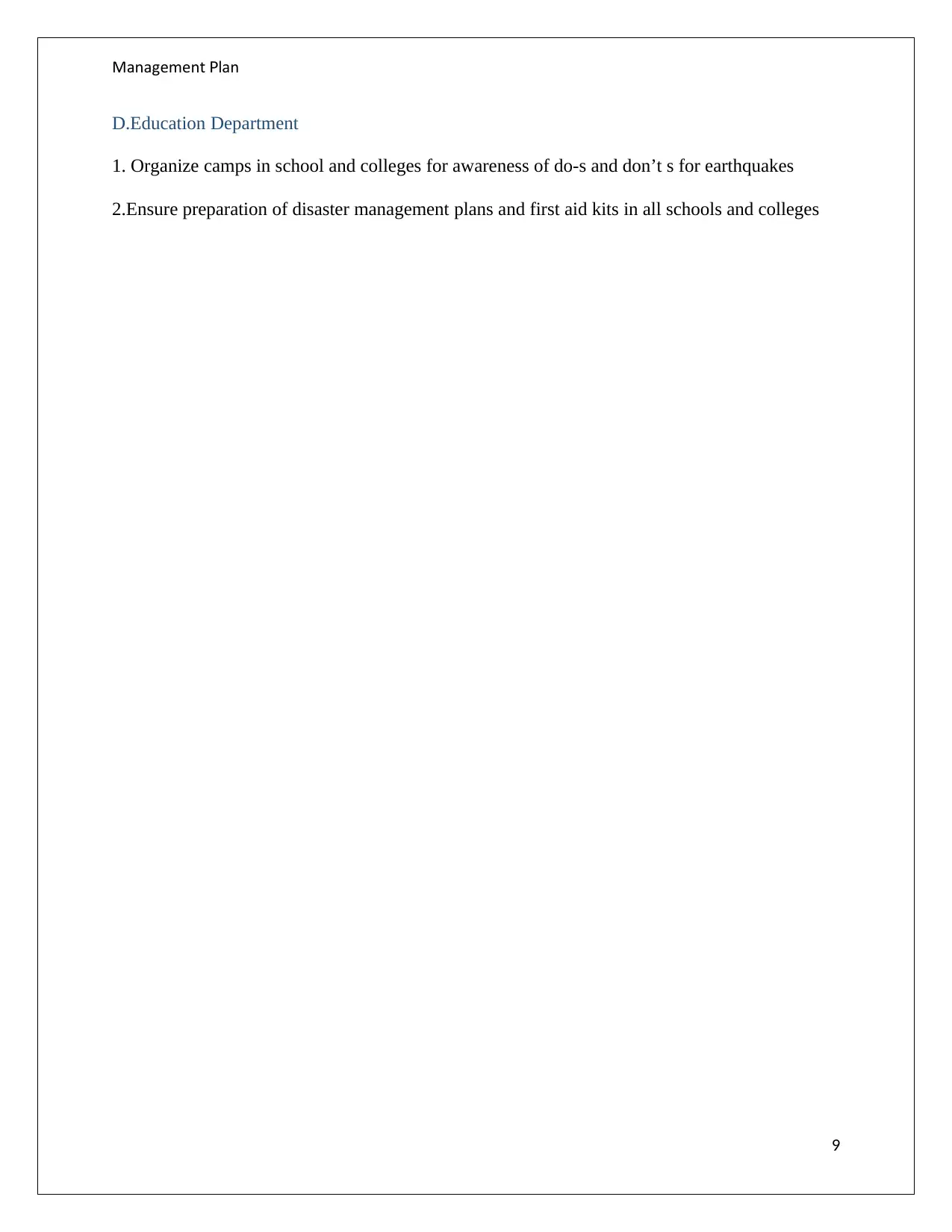
Management lanP
D.Education Department
1. Organize camps in school and colleges for awareness of do-s and don’t s for earthquakes
2.Ensure preparation of disaster management plans and first aid kits in all schools and colleges
9
D.Education Department
1. Organize camps in school and colleges for awareness of do-s and don’t s for earthquakes
2.Ensure preparation of disaster management plans and first aid kits in all schools and colleges
9
⊘ This is a preview!⊘
Do you want full access?
Subscribe today to unlock all pages.

Trusted by 1+ million students worldwide
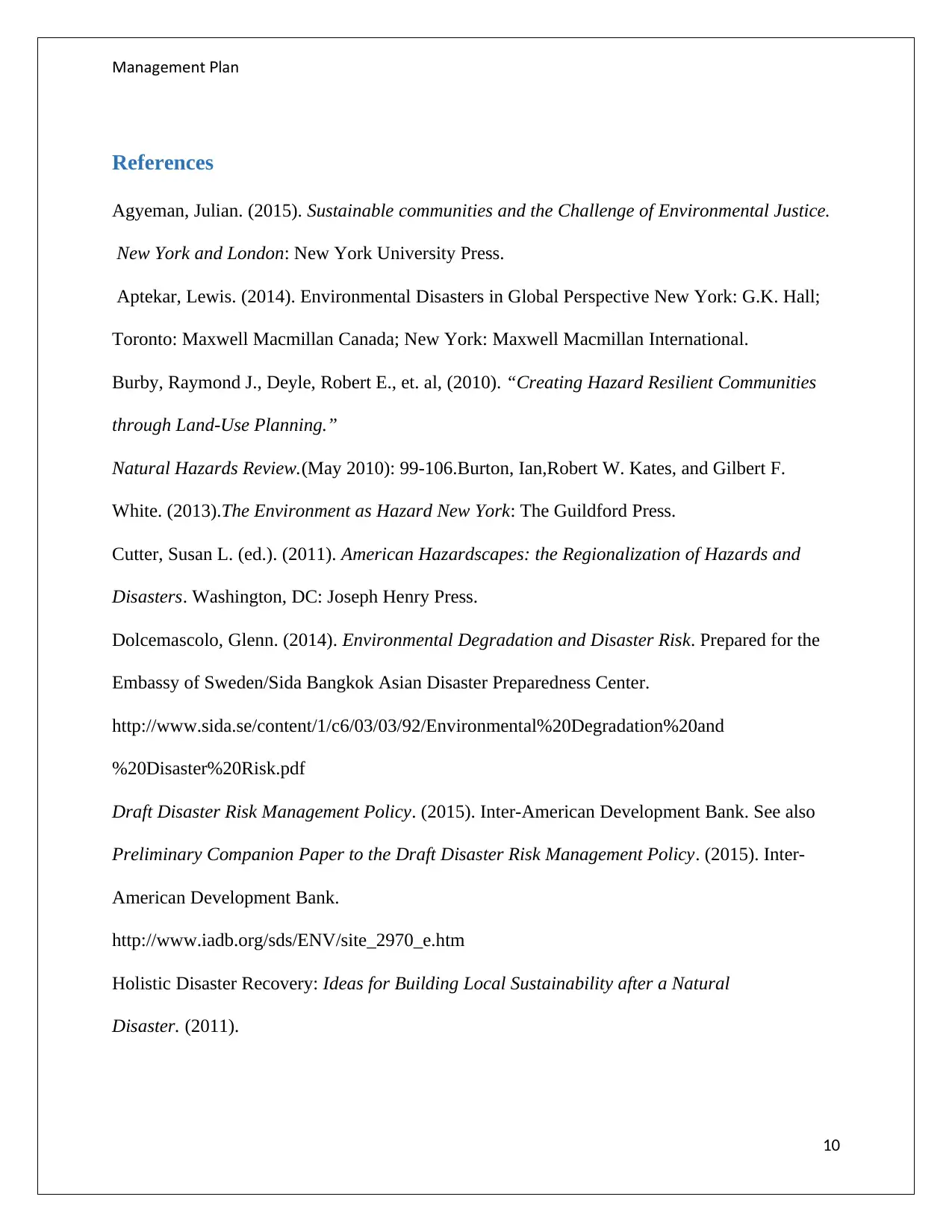
Management lanP
References
Agyeman, Julian. (2015). Sustainable communities and the Challenge of Environmental Justice.
New York and London: New York University Press.
Aptekar, Lewis. (2014). Environmental Disasters in Global Perspective New York: G.K. Hall;
Toronto: Maxwell Macmillan Canada; New York: Maxwell Macmillan International.
Burby, Raymond J., Deyle, Robert E., et. al, (2010). “Creating Hazard Resilient Communities
through Land-Use Planning.”
Natural Hazards Review.(May 2010): 99-106.Burton, Ian,Robert W. Kates, and Gilbert F.
White. (2013).The Environment as Hazard New York: The Guildford Press.
Cutter, Susan L. (ed.). (2011). American Hazardscapes: the Regionalization of Hazards and
Disasters. Washington, DC: Joseph Henry Press.
Dolcemascolo, Glenn. (2014). Environmental Degradation and Disaster Risk. Prepared for the
Embassy of Sweden/Sida Bangkok Asian Disaster Preparedness Center.
http://www.sida.se/content/1/c6/03/03/92/Environmental%20Degradation%20and
%20Disaster%20Risk.pdf
Draft Disaster Risk Management Policy. (2015). Inter-American Development Bank. See also
Preliminary Companion Paper to the Draft Disaster Risk Management Policy. (2015). Inter-
American Development Bank.
http://www.iadb.org/sds/ENV/site_2970_e.htm
Holistic Disaster Recovery: Ideas for Building Local Sustainability after a Natural
Disaster. (2011).
10
References
Agyeman, Julian. (2015). Sustainable communities and the Challenge of Environmental Justice.
New York and London: New York University Press.
Aptekar, Lewis. (2014). Environmental Disasters in Global Perspective New York: G.K. Hall;
Toronto: Maxwell Macmillan Canada; New York: Maxwell Macmillan International.
Burby, Raymond J., Deyle, Robert E., et. al, (2010). “Creating Hazard Resilient Communities
through Land-Use Planning.”
Natural Hazards Review.(May 2010): 99-106.Burton, Ian,Robert W. Kates, and Gilbert F.
White. (2013).The Environment as Hazard New York: The Guildford Press.
Cutter, Susan L. (ed.). (2011). American Hazardscapes: the Regionalization of Hazards and
Disasters. Washington, DC: Joseph Henry Press.
Dolcemascolo, Glenn. (2014). Environmental Degradation and Disaster Risk. Prepared for the
Embassy of Sweden/Sida Bangkok Asian Disaster Preparedness Center.
http://www.sida.se/content/1/c6/03/03/92/Environmental%20Degradation%20and
%20Disaster%20Risk.pdf
Draft Disaster Risk Management Policy. (2015). Inter-American Development Bank. See also
Preliminary Companion Paper to the Draft Disaster Risk Management Policy. (2015). Inter-
American Development Bank.
http://www.iadb.org/sds/ENV/site_2970_e.htm
Holistic Disaster Recovery: Ideas for Building Local Sustainability after a Natural
Disaster. (2011).
10
1 out of 10
Related Documents
Your All-in-One AI-Powered Toolkit for Academic Success.
+13062052269
info@desklib.com
Available 24*7 on WhatsApp / Email
![[object Object]](/_next/static/media/star-bottom.7253800d.svg)
Unlock your academic potential
Copyright © 2020–2025 A2Z Services. All Rights Reserved. Developed and managed by ZUCOL.





